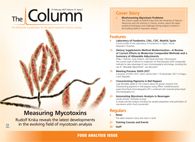Non-Targeted Screening Approaches for Food
Non-targeted screening approaches are an essential element of food safety strategies, detecting novel or unexpected food contaminants and adulterants. However, the development and implementation of generalized and non-targeted screening workflows for food matrices is challenging. The inherent sample complexity and diversity as well as large analyte concentration ranges represent significant obstacles.
Non-targeted screening approaches are an essential element of food safety strategies, detecting novel or unexpected food contaminants and adulterants. However, the development and implementation of generalized and non-targeted screening workflows for food matrices is challenging. The inherent sample complexity and diversity as well as large analyte concentration ranges represent significant obstacles.
A review published in the Journal of Chromatography A examines the use of liquid chromatography coupled to high-resolution mass spectrometry (LC–MS) to address these issues (1). Citing the reduction of sample complexity and ability to generate molecular formulae for compounds of interest as justification for the approach. The paper also covers the current capabilities, strategies, and challenges surrounding sample preparation, mass spectrometry, chromatography, and data processing workflows. Discussing approaches to increase the accuracy and speed of identifying unknown molecular species and offering suggestions for achieving sufficient data quality for nonâtargeted screening applications. - L.B.
Reference
- Ann M. Knolhoff and Timothy R. Croley, Journal of Chromatography A1428, 86–96 (2016).

Analytical Challenges in Measuring Migration from Food Contact Materials
November 2nd 2015Food contact materials contain low molecular weight additives and processing aids which can migrate into foods leading to trace levels of contamination. Food safety is ensured through regulations, comprising compositional controls and migration limits, which present a significant analytical challenge to the food industry to ensure compliance and demonstrate due diligence. Of the various analytical approaches, LC-MS/MS has proved to be an essential tool in monitoring migration of target compounds into foods, and more sophisticated approaches such as LC-high resolution MS (Orbitrap) are being increasingly used for untargeted analysis to monitor non-intentionally added substances. This podcast will provide an overview to this area, illustrated with various applications showing current approaches being employed.










